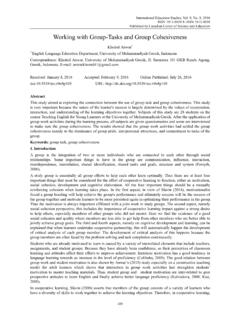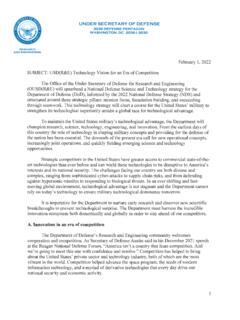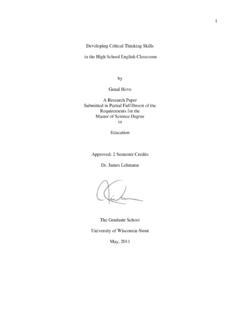Transcription of Understanding Critical Thinking to Create Better Doctors
1 9 JOURNAL OF ADVANCES IN MEDICAL EDUCATION AND RESEARCHU nderstanding Critical Thinking toCreate Better DoctorsAbstractMedical students master an enormous body ofknowledge, but lack systematic problem solving abilityand effective clinical decision making. High profile reportshave called for reforms in medical education to Create abetter generation of Doctors who can cope with thesystem based problems they would encounter in aninterdisciplinary and collaborative environment and makebetter reasoned decisions for quality patient care. Toachieve this Critical Thinking is at the very heart ofdevelopment of new medical knowledge.
2 Critical Thinking (CT) can be defined as the ability to identify and analyseproblems as well as seek and evaluate relevantinformation in order to reach an appropriate academics and practitioners have raisedconcerns about the low levels of Critical Thinking and stressthe need for fostering Critical Thinking amongmedicalpractitioners. This article attempts to provide aconceptual analysis of Critical Thinking with reference tomedical education along with measures to foster criticalthinking through relevant teaching learning and words: Critical Thinking , medical education, qualitypatient care, fostering Critical the 21st century, students must think their way throughabstract problems, work in teams, distinguish goodinformation from bad, and be multilingual and globally/environmentally sensitive so that they can be moreeffective in their disciplines.
3 These are the samecharacteristics expected of today s medical studentsalso.[1] Doctors are expected to take effective decisionsin well defined and ill defined medical , when they face undefined medical emergenciesthey are unable to take effective clinical decisions andthat leads to untoward incidents. One among the manyreasons for this is a lack of Critical Thinking skills amongdoctors. It has been reported that Critical Thinking shouldbe fostered at grassroots level among the medicalstudents which will promote Better decision making whenthey eventually The absence of anapprenticeship model of education and a lack ofemphasis on Critical Thinking and on acquisition of skillsand competencies has resulted in producing Doctors whoare incapable of independent practice.
4 [2]Health care is fallible and prone to diagnostic andmanagement errors. Approximately one third of patientproblems arise due to diagnostic errors. Part of thesolution lies in improving the diagnostic skills and criticalthinking abilities of physicians as they progress throughmedical school and residency training. [1] The medicalschool mustteach the principles of scientific method andevidence-based medicine, including analytical and criticalthinking, throughout the curriculum. [3]Health careeducation has emphasized Critical Thinking as an essentialskill for more than 50 years.
5 [4] Critical thinkers exhibitconfidence, contextual perspective, creativity, flexibility,inquisitiveness, intellectual integrity, intuition, openmindedness, perseverance, and reflections as their habitsof mind. The global minimum standards formedicaleducation puts forward the essential components ofmedical education which lists Critical Thinking andresearch as an important component. [5] This paperattempts to present a conceptual analysis of criticalthinking with reference to medical Zayapragassarazan, Vikas Menon1, SitanshuSekar Kar2, Gitanjali BatmanabaneDept. of Medical Education, 1 Dept.
6 Of Psychiatry and2 Dept. of Preventive and Social Medicine, JawaharlalInstitute of Postgraduate Medical Education and Research (JIPMER), Puducherry-605006, IndiaVolume 1 April-Dec 201610 JOURNAL OF ADVANCES IN MEDICAL EDUCATION AND RESEARCHWhat is Critical Thinking ?There are several key definitions for Critical Thinking toconsider. The American Philosophical Association (APA)defined Critical Thinking as purposeful, self-regulatoryjudgment that uses cognitive tools such as interpretation,analysis, evaluation, inference, and explanation of theevidential, conceptual, methodological, criteriological, orcontextual considerations on which judgment is based.
7 [6] Critical Thinking is the ability and willingness to assessclaims and make objective judgments on the basis ofwell-supported reasons. It is the ability to look for flawsin arguments and resist claims that have no supportingevidence. It also fosters the ability to be creative andconstructive to generate possible explanations forfindings, think of implications, and apply new knowledgeto a broad range of social and personal problems. [7] Critical Thinking , commonly referred to as rational/logicalthought, has its birthplace in philosophy. Thus, criticalthinking is a cognitive skill that can be taught and is assumed that Critical thinkers make Better decisions,are Better problem solvers and are professionally morecompetent.
8 [8]The simplest definition is offered by Beyer (1995): Critical Thinking means making reasoned judgments .In other words, Critical Thinking is a disciplined mannerof thought that a person uses to assess the validity ofsomething (statements, news stories, arguments,research, etc.).[9]Characteristics of Critical ThinkingWade (1995) has identified eight characteristics of criticalthinking.[10] Critical Thinking involves asking questions,defining a problem, examining evidence, analyzingassumptions and biases, avoiding emotional reasoning,avoiding oversimplification, considering otherinterpretations, and tolerating ambiguity.
9 Dealing withambiguity is also recognized as an essential part of criticalthinking. Ambiguity and doubt are a necessary and evena productive part of the Critical Thinking process. [11]Another characteristic of Critical Thinking identified bymany sources is metacognition. Metacognition is thinkingabout one s own Thinking . More specifically, metacognition is being aware of one s Thinking as oneperforms specific tasks and then using this awarenessto control what one is doing . [12]Beyer (1995) elaborately explains the essential aspectsof Critical Thinking .[9] They are:Dispositions: Critical thinkers are skeptical, open-minded, value fair-mindedness, respect evidence andreasoning, respect clarity and precision, look at differentpoints of view, and will change positions when reasonleads them to do : One must apply criteria to think critically andneed to have conditions that must be met for somethingto be judged as : Is a statement or proposition with supportingevidence.
10 Critical Thinking involves identifying,evaluating, and constructing : The ability to infer a conclusion from one ormultiple premises. To do so requires examining logicalrelationships among statements or of View: The way one views the world, whichshapes one s construction of meaning. In a search forunderstanding, Critical thinkers view phenomena frommany different points of for Applying Criteria: Other types of thinkinguse a general procedure. Critical Thinking makes use ofmany procedures. These procedures include askingquestions, making judgments, and in Critical thinkingHealth professionals use Critical Thinking skills when theyreflect on knowledge derived from other interdisciplinarysubject areas in order to provide a holistic health careto their patients.















